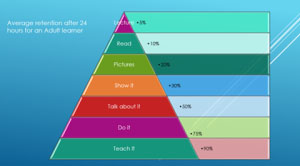Any professional in the enterprise imaging sector knows that new software implementations have their pros and cons. On the upside, whether it’s a new PACS, VNA, or information system deployment, the new software is usually being installed to help streamline end-user workflow, connect the full patient-imaging picture, or improve data security and storage capacity. What’s often perceived as a con, however, is the learning curve that comes with new software go-lives.
Make no mistake; learning a new software system is tough. That’s true for veteran staff members, who often know the legacy system like the back of their hand, as well as new hires, particularly in administrator-type roles, which often have high turnover rates. So, if you’re an imaging business, how do you strategically invest in training for your staff? How do you ensure that your employees learn the intricacies of a new system in a comprehensive yet cost-effective manner, particularly in those high turnover roles?
These are all valid questions that FUJIFILM Healthcare Americas Corporation’s Professional Services team frequently hears from organizations ready to make a system switch. Thankfully, it’s these inquiries that we’ve built our renowned training strategies to address.
One size doesn’t fit all Did you know that children and adults retain information in vastly different ways? There are even unique terms to describe them:
One of the most successful, research-backed strategies for designing adult learning courses uses the National Training Laboratories’ “learning pyramid.” This methodology focuses on training tools that optimize content retention:

I’m sure the findings outlined in this graphic aren’t too surprising. How many times have you been subject to an hour-long PowerPoint presentation during a seminar or conference, only to walk away feeling like the vast majority of material went in one ear and out the other? That’s because a “death by PowerPoint” approach, particularly for adults trying to learn a new software application, simply doesn’t work. So what does?
Here are the top-three training methods that optimize content retention in adult learners and the ways Fujifilm is putting them into practice to help streamline your success with Synapse®:
Talk about it Did you know forums, such as discussion groups, can increase cognitive retention from 15 to 50 percent? Something as simple as sitting down with your colleagues and discussing how they’re using a particular skillset can have a monumental impact on the quantity and quality of information you retain.
At Fujifilm, we offer a number of training modules that are centered around group-based discussions. Our Synapse Radiology, Cardiology PACS customers, for example, have access to complimentary, biweekly live Q&A sessions. These sessions alternate in format. Customers can take part in a fluid, 60-minute, open-forum conversation with Fujifilm’s Synapse System Administration Training (SSAT) experts and other Synapse PACS customers or attend a 30-minute session on a predetermined topic, followed by 30 minutes of open dialog. You can view the full 2023 Q&A schedule here. If you’re a Synapse Enterprise Information Systems (EIS) and Radiology Information Systems (RIS) customer, be on the lookout for a similar offering in the near future. In the meantime, we’ve also just introduced our concierge service to our EIS/RIS customer base. This offering allows our customers to “talk about it” one-on-one with our information system experts as needed on a monthly basis.
Do it Do those of you on the clinical side of enterprise imaging remember being asked to complete both written and practical exams in medical school? That was because there’s a distinct difference between knowing a skill and putting that skill into practice. Physically performing the skills you’re trying to master can help you retain nearly 75 percent of the material. Added bonus: It can also help ease those “first-day-of-school” jitters when you’re asked to start using those new skills on a day-to-day basis.
Fujifilm’s SSAT courses incorporate this “do-it” approach to content retention by offering kinesthetic modules within the training curriculum. You can learn more about Fujifilm’s versatile SSAT courses here.
Teach it “Train the trainer.” It’s a frequently used phrase. It’s also one of the most powerful tools to help adult learners fully grasp a new skill or concept. This approach results in 90 percent content retention after 24 hours. That alone is tough to argue with. The key to success for train the trainer is to include the trainee in the teaching process: Make sure they understand not only the material, but also the science behind it.
Fujifilm uses this approach with our own Professional Services team. We train our trainers on our extensive product features, functionalities, and workflows using proven learning methods that best resonate with adults. Using this train-the-trainer method helps ensure that our trainers not only have an in-depth understanding of our solutions, but also can effectively pass on that level of expertise to our customers during an implementation.
Our Professional Services team then takes the same approach when getting our customers up to speed on our software. Our trainers teach our clients’ personnel, especially those we consider to be “super-users,” in a way that not only optimizes their content retention but also enables them to train their current and future colleagues long after Fujifilm leaves the site. In fact, that’s one of the core reasons we’re considered to be an extension of our customers’ teams. We train our customers in a way that sets them up for success, both now and in the years to come.
Want to learn more about Fujifilm’s diverse enterprise imaging training programs and see which option may work best for you? Reach out to our Professional Services team for a consultation.